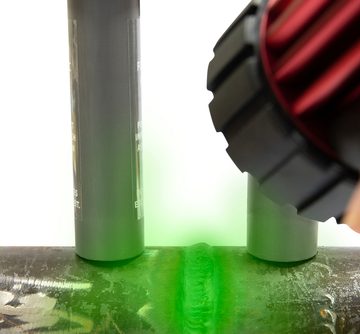UV Lamps are used in non destructive testing as part of magnetic particle inspection and liquid penetrant testing techniques. The standards for UV lamp testing are broadcast publicly to ensure high standards of operation, product reliability and the reliability of materials when non destructive testing techniques are in use. There are a few universal standards used to verify the efficacy of ultraviolent non destructive testing technology.
E2297
E2297 provides guidelines for safe and efficient operating procedures for traditional UV sources: UV radiometers and visible light meters. The two primary lamps covered by E2297 are mercury vapour lamps and speciality lamps.
UV Lamps In Radiometers
The emission spectrum for both mercury vapour and speciality lamps is different, but both require a UV-A pass-filter to ensure only UV-A light is emitted. E2297 gives definitions for the proper sensitivity range and calibration required for UV NDT applications. The UV-A range is defined as 320-400 nm, and a suitable radiometer must include filters to restrict the meter response to that range.
UV Lamps In Visible Light Meters
E2297 also gives the proper sensitivity range and calibration for visible light meters. In non destructive testing, the visible light range is defined as 400-760 nm. And as with radiometers, the visible light meter must include filters to restrict the response to the proper range. Many meters on the retail level do not have the proper filters to measure in this range, and therefore would not be suitable for use in NDT applications.
ASTM E3022
This standard establishes performance benchmarks for LED UV-A lamps used in magnetic particle inspection and liquid penetrant testing. E3022 provides standards used in information gathering and data collection techniques. The standards are relevant to UV-A lamp manufacturers only. Model type testing and individual unit testing is required to certify UV-A lamps as compliant with NDT standards.
Model Type Testing
Model type testing is used to certify a beam profile, minimum working distance, maximum lamp temperature, stabilisation time and UV-A pass-filter transmission profile of a UV-A lamp. Analysis of the emission spectrum is also part of the standard and includes peak wavelength, full peak width at half maximum (FWHM), longest wavelength at half-maximum (LWHM), and irradiance in the excitation range (347-382 nm).
Individual Unit Testing
Individual unit testing provides an evaluation of the emission spectrum and the maximum iridescence of an individual lamp product. While E3022 details the manufacturer requirements for LED lamps, it does not include checks performed by the user. Checks such as UV-A intensity and lamp integrity are the same with LED lamps as with other UV sources.
If you are looking for UV lamp non destructive testing equipment, check out NDT Australia’s online store. We supply a range of magnetic particle and liquid penetrant testing equipment that uses a UV lamp for use in shipping, mining, oil rigs, construction and other fields of engineering. We are open for business Monday to Friday, 7:30am to 4:00pm. Contact our friendly sales team on (02) 9524 0558 to ask any questions or to place an order for any of the products listed on our online store.


